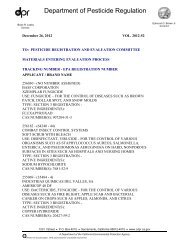Dichlorvos (DDVP) Risk Characterization Document - California ...
Dichlorvos (DDVP) Risk Characterization Document - California ...
Dichlorvos (DDVP) Risk Characterization Document - California ...
Create successful ePaper yourself
Turn your PDF publications into a flip-book with our unique Google optimized e-Paper software.
No clinical signs were reported; however, Tyl et al. (1992) suggested that the signs could have been<br />
missed because rats were nocturnal animals and the consumption of <strong>DDVP</strong> in the water was highest<br />
at night. There were dose-related decreases in the plasma, erythrocyte, and brain ChE activities of all<br />
F 0 and F 1 adults, and the levels of inhibition at 20 and 80 ppm were statistically significant (p @ 0.05)<br />
(Table 11). The inhibition of ChE activity was greater in the females than in the males because the<br />
females were exposed to <strong>DDVP</strong> for a longer time (during gestation and lactation also) and their<br />
dosages were higher. The NOAEL for plasma, erythrocyte, and brain ChE inhibition was 5 ppm (0.5<br />
mg/kg-day for the males and 1.1 mg/kg-day for the females). It should be noted that a LOEL of 5 ppm<br />
may be established for the inhibition of erythrocyte ChE activity of the F 0 females and F 1 both sexes<br />
as well as plasma ChE activity for the F 1 males.<br />
There was no evidence of pathological effects in the reproductive organs. The only significant effect<br />
observed in the pups was the reduction in the body weights of the 80 ppm F 1 pups on postnatal days<br />
14 and 21. After weaning the F 2 a litters, the F 1 females were exposed to <strong>DDVP</strong> again and mated with<br />
untreated males for the F 2 b litters. There was a reduction (not statistically significant) of fertility at 80<br />
ppm. The number of "abnormal" cycles in the 80 ppm F 1 females was significantly higher (68%) than<br />
in the controls (16%). The NOEL for reproductive toxicity and non-cholinergic endpoints was 20 ppm<br />
(2.7 mg/kg-day estimated from the premating dosage for females) based on the reduction of water<br />
consumption, body weight, fertility, and estrous cycling. This study was considered acceptable to<br />
DPR according to FIFRA guidelines.<br />
Inhalation - Mouse<br />
Crl:CD-1 mice (number of mice used not specified) were exposed to <strong>DDVP</strong> by inhalation during<br />
breeding (Casebolt et al., 1990). Resin strips (1 by 2.5 inch, 2 by 2.5 inch, and 4 by 2.5 inch) were<br />
placed in the food hopper 4 days prior to mating and continued throughout pregnancy. The air<br />
concentrations measured on day 1 were 1.9 ± 1.2, 3 ± 2.2, and 4.6 ± 2.0 mg/m 3 for the three sizes of<br />
strips, respectively, but were not maintained throughout the experiment. The estimated dosages for<br />
the three air concentrations of day 1 were 3.4, 5.7, and 8.3 mg/kg-day. There were no effects on the<br />
reproductive performances as determined by litter frequency and mean litter size. No clinical signs<br />
were observed. Plasma ChE activity of the treated dams were depressed on days 4 and 7, but not on<br />
day 14. The plasma ChE activity was maximally inhibited on day 4 to 10%, 7%, and 6% of control<br />
values for 1.9, 3, and 4.6 mg/m 3 groups, respectively.<br />
45
















